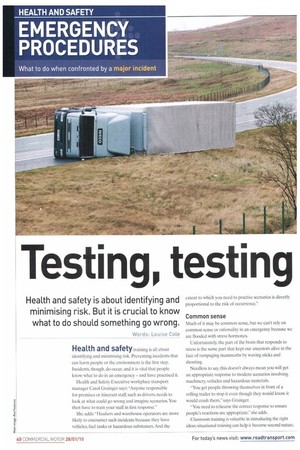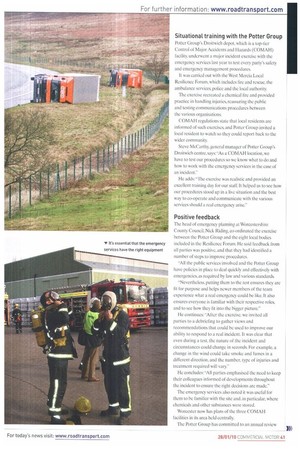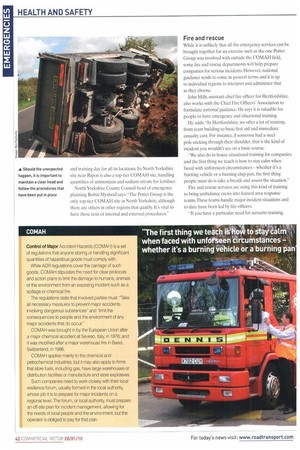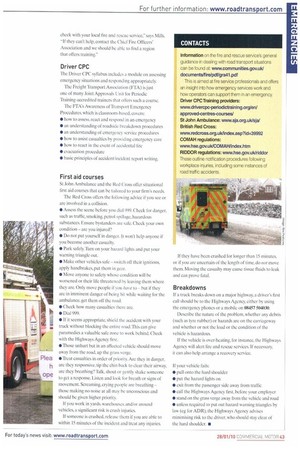Testing, testing
Page 40

Page 41

Page 42

Page 43

If you've noticed an error in this article please click here to report it so we can fix it.
Health and safety is about identifying and minimising risk. But it is crucial. to know what to do should something go wrong.
Words: Louise CoLe Health and safety training is all about identifying and minimising risk. Preventing incidents that can harm people or the environment is the first step. Incidents, though, do occur, and it is vital that people know what to do in an emergency — and have practised it.
Health and Safety Executive workplace transport manager Carol Grainger says: "Anyone responsible for premises or itinerant staff, such as drivers, needs to look at what could go wrong and imagine scenarios. You then have to train your staff in first response.
She adds: "Hauliers and warehouse operators are more likely to encounter such incidents because they have extent to which you need to practise scenarios is directly proportional to the risk of occurrence."
Common sense
Much of it may be common sense, but we can't rely on common sense or rationality in an emergency because we are flooded with stress hormones.
Unfortunately, the part of the brain that responds to stress is the same part that kept our ancestors alive in the face of rampaging mammoths by waving sticks and shouting.
Needless to say, this doesn't always mean you will get an appropriate response to modern scenarios involving machinery, vehicles and hazardous materials.
-You get people throwing themselves in front of a rolling trailer to stop it even though they would know it would crush them," says Grainger.
"You need to rehearse the correct response to ensure people's reactions are appropriate," she adds.
Classroom training is valuable in introducing the right ideas; situational training can help it become second nature.
Situational training with the Potter Group
Potter Group's Droitwich depot, which is a top-tier Control of Major Accidents and Hazards (COMAH) facility, underwent a major incident exercise with the emergency services last year to test every party's safety and emergency management procedures.
It was carried out with the West Mercia Local Resilience Forum, which includes fire and rescue, the ambulance services, police and the local authority.
The exercise recreated a chemical fire and provided practice in handling injuries, reassuring the public and testing communications procedures between the various organisations.
COMAH regulations state that local residents are informed of such exercises. and Potter Group invited a local resident to watch so they could report back to the wider community.
Steve McCarthy, general manager of Potter Group's Droitwich centre, says: "As a COMAH location, we have to test our procedures so we know what to do and how to work with the emergency services in the case of an incident."
He adds: "The exercise was realistic and provided an excellent training day for our staff. It helped us to see how our procedures stood up in a live situation and the best way to co-operate and communicate with the various services should a real emergency arise."
Positive feedback
The head of emergency planning at Worcestershire County Council, Nick Riding, co-ordinated the exercise between the Potter Group and the eight local bodies included in the Resilience Forum. He said feedback from all parties was positive, and that they had identified a number of steps to improve procedures.
"All, the public services involved and the Potter Group have policies in place to deal quickly and effectively with emergencies, as required by law and various standards.
"Nevertheless, putting them to the test ensures they are fit for purpose and helps newer members of the team experience what a real emergency could be like. It also ensures everyone is familiar with their respective roles, and to see how they fit into the bigger picture."
He continues: "After the exercise, we invited all parties to a debriefing to gather views and recommendations that could be used to improve our ability to respond to a real incident. It was clear that even during a test. the nature of the incident and circumstances could change in seconds. For example, a change in the wind could take smoke and fumes in a different direction, and the number, type of injuries and treatment required will vary."
He concludes: "All parties emphasised the need to keep their colleagues informed of developments throughout the incident to ensure the right decisions are made."
The emergency services also noted it was useful for them to be familiar with the site and, in particular, where chemicals and other substances were stored.
Worcester now has plans of the three COMAH facilities in its area held centrally.
'he Potter Group has committed to an annual review and training day for all its locations. Its North Yorkshire site near Ripon is also a top-tier COMAH site, handling quantities of ammonium and sodium nitrate for fertiliser.
North Yorkshire County Council head of emergency planning Robin Myshrall says: -The Potter Group is the only top-tier COMAH site in North Yorkshire, although there are others in other regions that qualify It's vital to have these tests of internal and external procedures."
Fire and rescue
While it is unlikely that all the emergency services can he brought together for an exercise such as the one Potter Group was involved with outside the COMAH field, some fire and rescue departments will help prepare companies for serious incidents. However, national guidance tends to come in general terms and it is up to individual regions to interpret and administer that as they choose.
John Mills, assistant chief fire officer for Hertfordshire, also works with the Chief Fire Officers' Association to formulate national guidance. He says it is valuable for people to have emergency and situational training.
He adds: "In Hertfordshire, we offer a lot of training, from team building to basic first aid and immediate casualty care. For instance, if someone had a steel pole sticking through their shoulder, that is the kind of incident you wouldn't see on a basic course.
-We also do in-house situational training for companies. and the first thing we teach is how to stay calm when faced with unforeseen circumstances — whether it's a burning vehicle or a burning chip-pan, the first thing people must do is take a breath and assess the situation."
Fire and rescue services are using this kind of training to bring ambulance crews into hazard area response teams. These teams handle major incident situations and to date have been led by fire officers.
-If you have a particular need for scenario training, check with your local fire and rescue service,says Mills, 'If they can't help, contact the Chief Fire Officers' Association and we should be able to find a region that offers training."
Driver CPC
The Driver CPC syllabus includes a module on assessing emergency situations and responding appropriately.
The Freight Transport Association (ETA) is just one of many Joint Approvals Unit for Periodic Training-accredited trainers that offers such a course.
The ETA's Awareness of Transport Emergency Procedures, which is classroom-based, covers: • how to assess, react and respond in an emergency • an understanding of roadside breakdown procedures • an understanding of emergency service procedures • how to assist casualties by providing emergency care • how to react in the event of accidental lire • evacuation procedure • basic principles of accident/incident report writing.
First aid courses
St John Ambulance and the Red Cross offer situational first aid courses that can be tailored to your firm's needs. The Red Cross offers the following advice if you see or are involved in a collision.
• Assess the scene before you dial 999. Check for danger. such as traffic, smoking, petrol spillage, hazardous substances. Ensure bystanders are safe. Check your own condition — are you injured?
• Do not put yourself in danger. It won't help anyone if you become another casualty.
• Park safely. Turn on your hazard lights and put your warning triangle out.
• Make other vehicles safe — switch off their ignitions, apply handbrakes, put them in gear.
• Move anyone to safety whose condition will he worsened or their life threatened by leaving them where they are. Only move people if you have to — but if they are in imminent danger of being hit while waiting for the ambulance, get them off the road.
• Check how many casualties there are.
• Dial 999.
• If it seems appropriate, shield the accident with your truck without blocking the entire road.This can give paramedics a valuable safe zone to work behind. Check with the Highways Agency first.
• Those unhurt but in an affected vehicle should move away from the road, up the grass verge.
• Treat casualties in order of priority. Are they in danger, are they responsive, tip the chin back to clear their airway, are they breathing? Talk, shout or gently shake someone to get a response. Listen and look for breath or signs of movement. Screaming, crying people are breathing -those making no noise at all may be unconscious and should be given higher priority.
If you work in yards. warehouses. and/or around vehicles, a significant risk is crush injuries.
If someone is crushed, release them if you are able to within 15 minutes of the incident and treat any injuries. If they have been crushed for longer than 15 minutes. or if you are uncertain of the length of time, do not move them. Moving the casualty may cause tissue fluids to leak and can prove fatal.
Breakdowns
If a truck breaks down on a major highway, a driver's first call should be to the Highways Agency, either by using the emergency phones or a mobile on 08457 504030.
Describe the nature of the problem, whether any debris (such as tyre rubber) or hazards are on the carriageway and whether or not the load or the condition of the vehicle is hazardous.
If the vehicle is over-heating, for instance, the Highways Agency will alert lire and rescue services. If necessary, it can also help arrange a recovery service.
If your vehicle fails: • pull onto the hard shoulder • put the hazard lights on • exit from the passenger side away from traffic • call the Highways Agency first, before your employer • stand on the grass verge away from the vehicle and road • unless required to put out hazard warning triangles by law leg for ADR), the Highways Agency advises minimising risk to the driver, who should stay clear of the hard shoulder. •
















































































































































